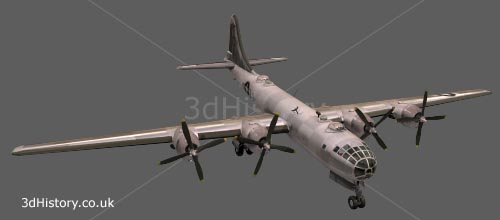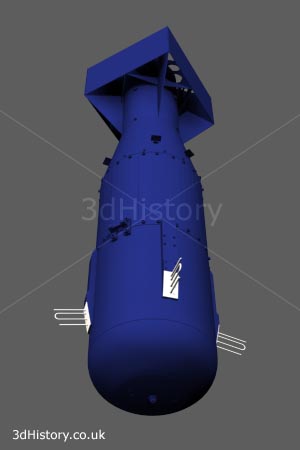The Second World War - The Atomic Age - World War Two - War Machines
The Atomic Age
The Atomic Age began with the end of the war when two atomic bombs were dropped on the Japanese cities of Hiroshima and Nagasaki.
Germany had one last card to play, the so-called revenge weapons: the V-1 flying bomb and the V-2 rocket. These were a last ditch attempt to alter the course of the war and the threat was finally countered when the launch sites were overrun by Allied ground troops. Germany formally surrendered on May 7th and May 8th 1945.

The Fieseler Fi 103 was otherwise known as the V-1, "Buzz Bomb" or "Doodlebug". They were not a very accurate weapon. They were fired from ramps situated in France and aimed mainly at London. The engine was timed to cut-out after a certain period calculated to make it over the intended target. The bomb would then crash to the ground and explode. The defence included attacks against the launch sites and fast aircraft tipping the wing to make them crash. Anti-aircraft fire accounted for a large proportion of kills.
|
The A4 rocket, also known as the V-2, was developed by the Nazis to deliver an explosive warhead to a target at long range. They were fired vertically from mobile platforms. At a specific height the engine cut-out and the rocket continued on in a ballistic arc, dropping on to the target from a height of around 100 km with little warning at speeds in excess of 3,000 kph. After the war the A4 became the basis for rocket research in the USA and USSR, which culminated in the Apollo missions to the Moon and Intercontinental Ballistic Missiles intended to deliver atomic war heads to targets situated across the globe. |
|
Japan continued to fight and it took special measures to convince her to cease hostilities.

The Boeing B29 Superfortress was the US Air force's long range strategic bomber. It's range of over 5,000 km enabled it to attack the Japanese homeland from bases in China and the Pacific Marianas islands. "Enola Gay" was the B29 that dropped the first Atomic Bomb on Hiroshima on August 6th 1945 killing over 60,000 people and injuring a similar number.
|
The first atomic bomb to be dropped on Japan was called Little Boy. It was a Uranium based device that yielded the equivalent of around 15 kilo tonnes of conventional explosives. It was a simple "gun" type device being detonated by firing one piece of uranium into another at high speed. However it was considered to be inherently unsafe due to the possibility of accidental detonation and the design wasn't used again. |
|
|
|
A second atomic bomb, code-named "Fatman", was dropped on the Japanese city of Nagasaki on August 9th 1945. The device was a solid core of plutonium compressed to a critical density by detonating shaped explosive charges arranged around it. "Fatman" produced a yield equivalent to about 21 kilo tonnes of conventional explosives and killed nearly 40,000 people, injuring a further 25,000. |
On August 15th 1945 Japan surrendered ending the Second World War and ushering in a new "Atomic Age".



